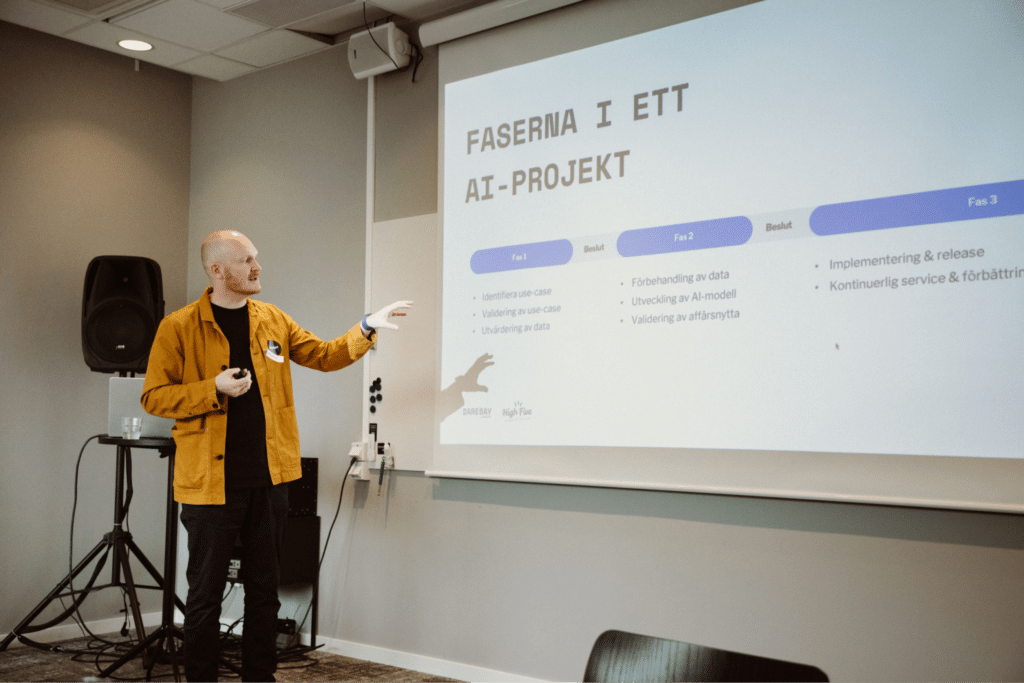
Embark on an AI Sprint for AI-Driven Success!
Do you want to strengthen your competitiveness and take the first step towards becoming an AI-driven organization? Then an AI sprint could be the perfect starting point!

The AI Design Sprint
Design sprints or innovation sprints are a process designed to help companies move forward with their innovation efforts in a short period of time.
The purpose of a sprint is to short-circuit the path from a challenge within an organization or product to produce a first proposal for a solution in a short time, which is also tested. A sprint is not intended to replace regular design processes, but to bring new energy, create consensus, make joint decisions and listen to customers.
AI is now on everyone’s lips and many organizations are thinking about how AI could be used in their organizations. In this question, there are many perspectives to consider. To support this process, we have developed an AI Sprint. In this customized sprint, the purpose is not primarily to get something fast but instead to look at their organization with new perspectives and create a picture of where AI can create value.
We will look at the challenges within the organizations based on the superpowers that AI possesses, what opportunities there are to create benefits, but also where there are pitfalls that should be avoided. In the end, it is about identifying what value AI could create, within the organization but also towards customers and end users. Unlike the usual sprint setup that extends over four days, here we have shortened it to two half days.
Part 1: Research
The first part of the sprint starts with inspiration and perspectives on AI-driven organizations led by Mikael Wiberg, professor at Umeå University in the field.
Based on these insights, processes in your own organization are analyzed to identify and prioritize challenges based on the strengths that AI possesses and where the technology can be used in the best way. The perspective then shifts to focus on opportunities and how AI can be used as a design material to develop new value-creating ideas.

Part 2: Concepts
In the second and final part of the AI sprint, ideas are developed into concrete concepts. These are evaluated and prioritized based on complexity, potential user value and available (and secure) data. Questions and hypotheses are filled in using templates developed for the purpose, and a test plan is designed to facilitate the next step – building and testing the concept for real.
Prototype development and testing is a possible addition to the sprint and will be unique to each organization. Prototyping can range from creating and testing experiences with end users, analyzing data, training models, to evaluating available technical AI solutions.

“This AI sprint is a fantastic addition to our offering and we look forward to being able to inspire and support organizations to take a first, thoughtful step into the future in 2023.” – Fredrik Johansson, Design Lead at Daresay by Knightec
AI Sprint benefits
One of the advantages of conducting an AI Sprint and then moving on to prototype development and testing is that you as a company get practical experience of how AI can be used in your business and gain new perspectives on data security, transparency and ethics.
Another advantage is that you can get support and guidance from experts in the field. This can be very helpful in navigating the complex world of AI and finding the right technical solutions for your needs.
In conclusion, this AI Sprint is a good first step for organizations that want to better understand the potential of AI to improve their business. By identifying the areas where the technology can create the most value and by developing a concrete AI solution, you can start your learning process in the area and sow a seed for increased competitiveness and strengthened position in the market.